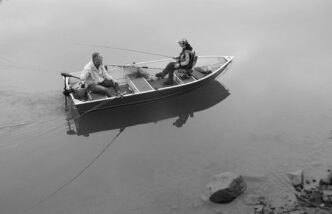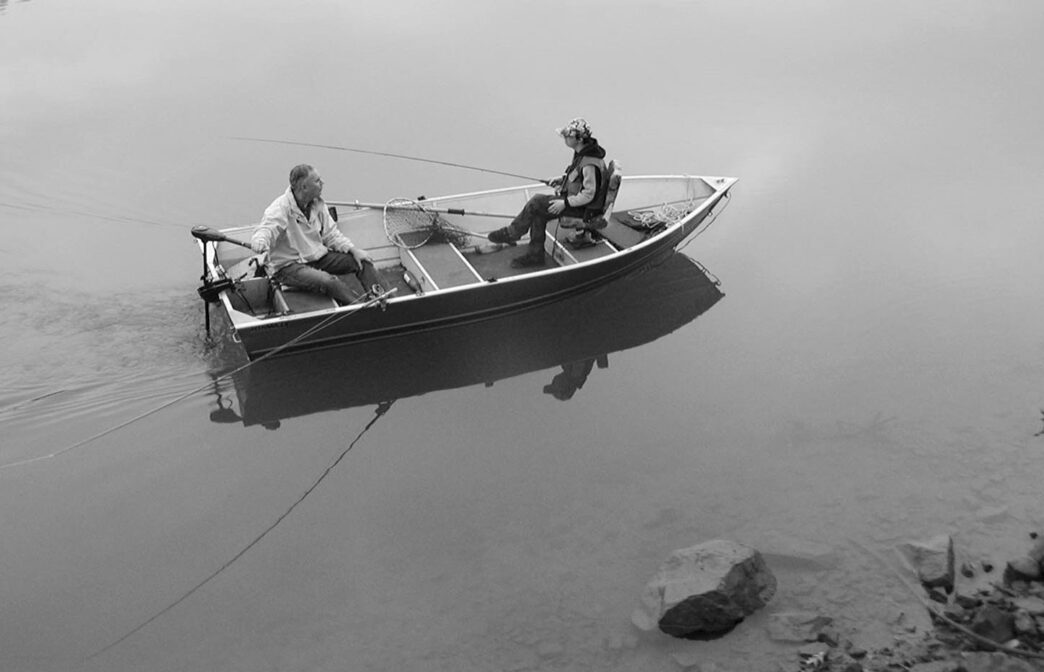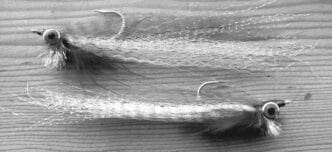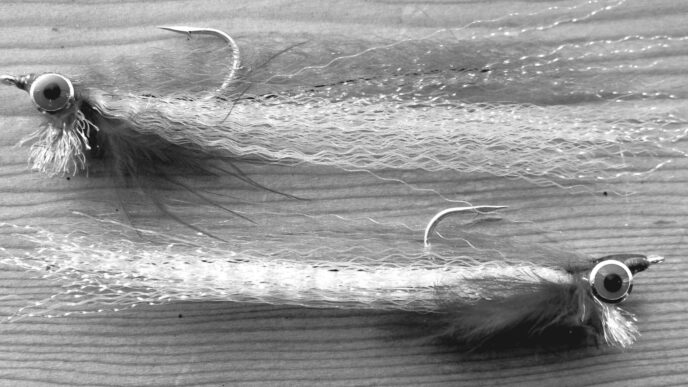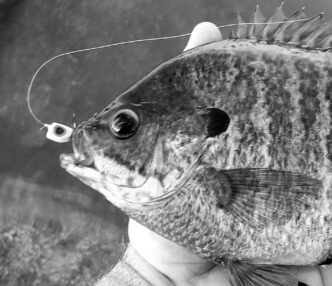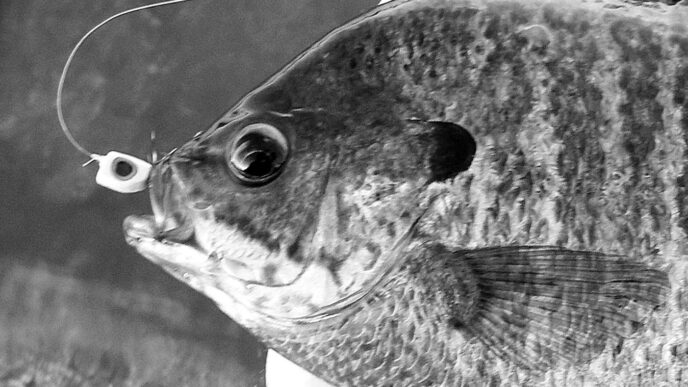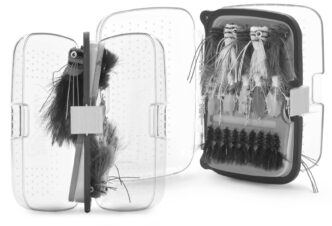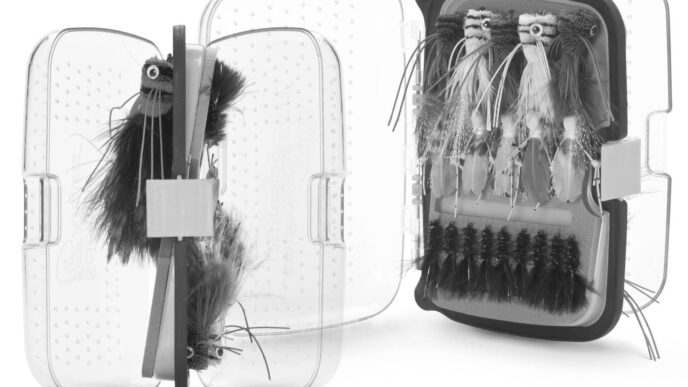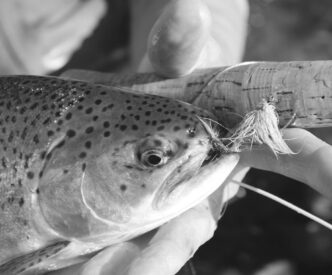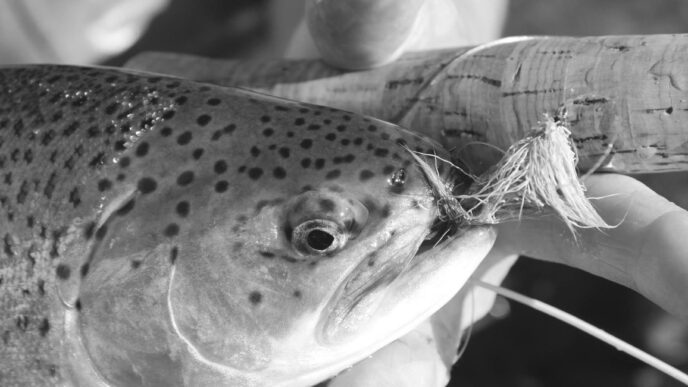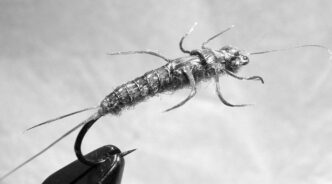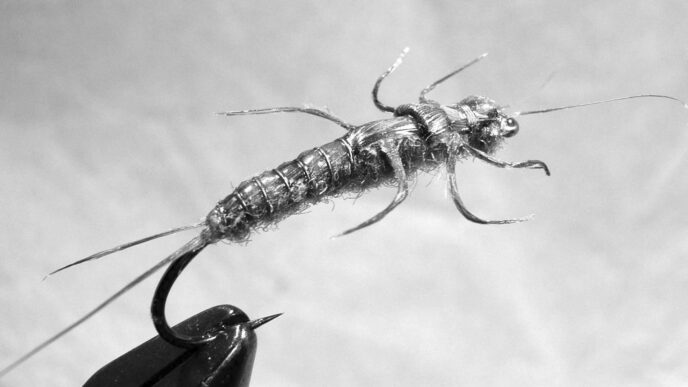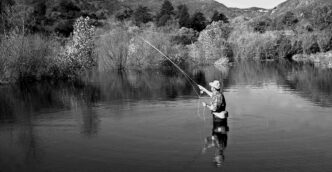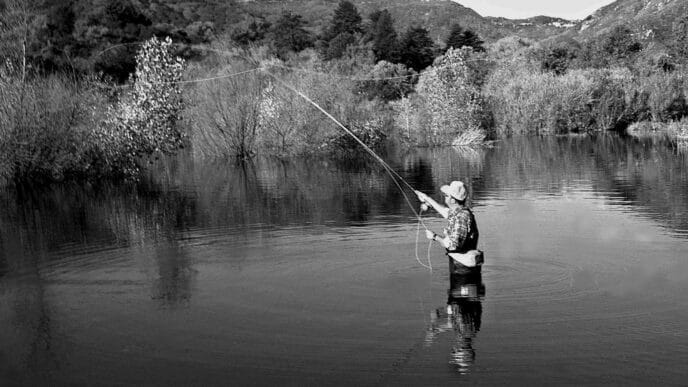Although fly fishing is primarily thought of as casting insect-imitating patterns to trout in flowing waters, there is a rich tradition of pulling minnow-imitating streamers on lakes. Yes, I am referring to trolling. I suspect we have all left our lines in the water as we kicked our float tube to the next spot on a lake. That is how it starts. The next step on this slippery slope is to get a set of oars for a pontoon boat. Add an electric trolling motor, and you are flirting with the dark side of fly fishing. Other waypoints on this path might include rod holders, fish finders, and a second-rod stamp for your license. You can easily maintain the image of a fly angler while dragging flies in lakes. The gear you need is already in your kit. A 6-weight to 8-weight rod with a sink-tip line or sinking shooting head and 25 feet of 2X fluorocarbon will be all you need for starters. The other accoutrements will come with time. As long as your fellow anglers aren’t in the boat with you, you can maintain the deception.
I admit to having embraced this heresy. More big fish eat other fish than sip midges. For well over 100 years, fly anglers in North America have been trolling with flies. The Rangeley Lakes in Maine were home to the first cult of trolling fly anglers. The baitfish were smelt, and many patterns were developed on 8X-long hooks to be pulled behind an oar-propelled boat. The go-and-glide motion of rowboats, canoes, and kayaks will animate a fly much better than an electric or gas motor. Many of these patterns were brightly colored and represent the attractor school of fly design. The best-known pattern from that era is the Gray Ghost, which is still available in some fly shops.
The invention of spoons, spinners, and lipped diving plugs held the attention of trollers through most of the twentieth century, but there has been a resurgence of trolling with flies in the last 25 years on selected waters. New England anglers still use smelt patterns on many lakes. Anglers on the Great Lakes troll flies for salmon. Most of their patterns are tube flies reverse-tied with Flashabou.
On Lake Pend Orielle in the panhandle of Idaho, one of the most productive lures for large rainbows and mackinaws is a bucktail fly known as the Frisky Jenny. It is a tandem-hook fly and comes in dozens of color combinations. It is responsible for winning the Lake Pend Orielle fishing tournament in numerous years, outproducing all types of gear-angler hardware.
The saltwater anglers of the Pacific Northwest have been “bucktailing” for salmon for more than half a century. They fish Deceivers and many variations on tube flies directly in the prop wash of their boats. The most popular tube flies in recent years have been Grand Slam Bucktails. These are candlefish imitations up to five inches long. The common denominator for most salmon trolling flies is the abundant flash that is used in the construction. They feature a bucktail core with a Krystal Flash overlay.
The Role of Jay Fair
The center for trolling with flies in Northern California is Eagle Lake. Trolling also has a following at Lake Davis and at Klamath Lake, just across the Oregon border. The man most responsible for the popularity of trolling flies on these lakes is Jay Fair, who was profiled in the January/February 2010 issue of California Fly Fisher. He developed his own fly style and the technique to fish his trolling flies on fly lines.
Fly lines are best suited to shallowwater trolling. Eagle Lake, Lake Davis, and Klamath Lake are primarily shallow, high-desert stillwaters with prolific food chains that grow trout quickly. Jay Fair builds a trolling line that is 90 feet of floating level line, tipped with a lead-core section of 10 to 20 feet and by an 8-pound test monofilament leader of 35 feet.
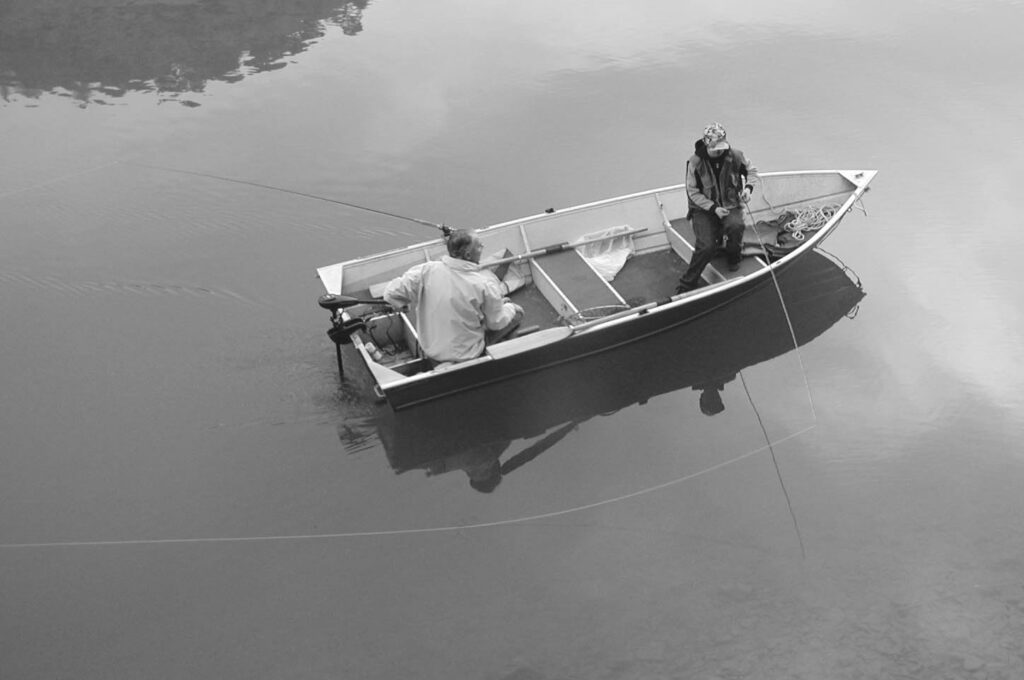
He also has developed a technique to animate his flies when trolled behind a motorboat. With the entire fly line in the water and his rod pointed behind the boat, he throws a mend into the line and then lets the mend pull back into the track of the boat. The mend is only a foot or so off to the side. He repeats the mend as soon as the line is again taut. This produces a pulsing motion that gives the fly a swimming action.
Another way to make trolling flies swim is to slide a small plastic disc or cone onto the tippet in front of the fly. These devices, available from retailers, shake the fly from side to side and create a turbulence that lifts the materials to give the appearance of bulk.
The original Jay Fair Trolling Fly is built on a 4X-long size 2 hook. It has a Crystal Chenille body with a marabou wing and tail. Most of the color combinations are attractor colors — the all-around best combination is an orange wing over yellow body. The colors were developed for Eagle Lake, where leeches and tui chub minnows are at the top of the menu for trout.
The most recent California-designed trolling patterns are from Arctic Fox Trolling Flies. As the name implies, they are tied with fox fur. They come in a number of minnow-inspired patterns, such as the Lahontan Redside Minnow, the Tui Chub, the Shad, and the UV Pond Smelt.
Design Theory for Trolling Flies
I categorize trolling-fly materials into three types: feather, fur, and synthetics. Feathers, designed for flight, are light and tend to be delicate. Marabou has tremendous movement, but does not stand up well to teeth. Saddle hackle wings can be made more durable if you double them up.
Fur is designed to protect the animal and is more durable than feathers. Bucktail is the traditional fur used for trolling flies. It is stiff when first immersed in water, but softens considerably after 10 minutes or so. There is a noticeable change in the action after bucktail is thoroughly soaked. The shortcoming of bucktail is that after repeated soaking and drying, the fur gets brittle and will break easily. You can prevent this if you use glycerin to dress the fly and keep the fibers soft.
The furs now gaining popularity for trolling flies are arctic fox and angora goat. These are supple, yet strong. They have the movement of marabou with the tensile strength of fur. They are white and take dye well.
If you want to get serious about trolling with flies for larger fish, I recommend that you forego Woolly Bugger patterns and fish with larger baitfish imitations from three inches long on up to six inches or more. Large fish are much more interested in big flies. The Department of Fish and Game estimates that larger fish eat 40 percent of the trout planted in the Sierra District.
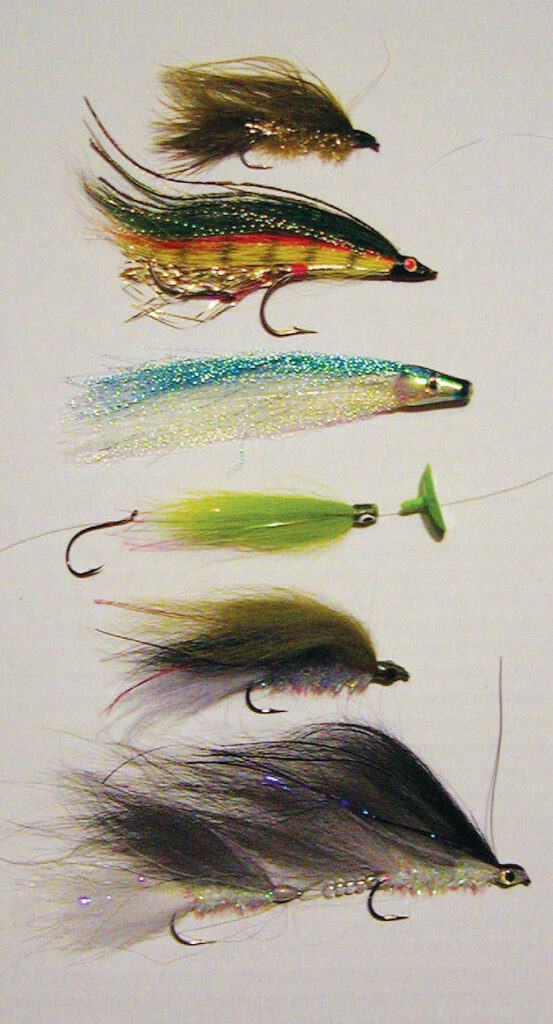
TROLLING FLIES, FROM TOP TO BOTTOM:
JAY FAIR TROLLING FLY, #2 HOOK, 2.5 INCHES IN LENGTH
FRISKY JENNY #3/0 HOOK (TANDEM), 4 INCHES IN LENGTH
GRAND SLAM BUCKTAIL (TUBE FLY), 4 INCHES IN LENGTH
ARCTIC FOX TUBE FLY, #2 HOOK (WITH WIGGLE FIN ACTION DISC), 3 INCHES IN LENGTH
ARCTIC FOX TROLLING FLY, #2 HOOK, 3 INCHES IN LENGTH
ARCTIC FOX TANDEM, #2 HOOK, 5.5 INCHES IN LENGTH
Trolling Speed and Tactics
Trolling speed can be a factor and should be adjusted to the species being targeted. Trollers who seek rainbows often cruise at speeds of 1.2 to 2 miles per hour. Kokanee salmon like a similar speed. Browns, cohos, and king salmon will chase faster presentations, from 2 to 3 miles per hour or more. If you do not have a GPS unit to determine speed, here are some speed estimates based on my experience. A 12-foot aluminum boat rowed steadily will move about 2 miles and hour. You need to back off to hit 1.5 miles an hour. A small electric trolling motor will go about 1 mile per hour for each number on the motor’s five-speed scale. That’s in a calm or slight tailwind. Going into the wind, you need to move the speed up a notch.
Even though trolling is a searching technique that covers a lot of area, you should focus on specific locations. Warm water concentrates trout, and cold water scatters them. During the warm season, trout are concentrated near cool water. The classic example is found at Klamath Lake, where water temperatures in August can rise into the high 70s. The trout at this time of year gather near springs or head into the tributaries. These fish are shallow enough to reach with fly lines. Other lakes however, can be different. When the water warms up at Eagle Lake, for example, trout will go deep in its south end, well below the reach of most fly tackle.
During cold-weather months, trout scatter. To find the fish, you must locate their food. In the deeper lakes, the obvious inlets and outlets attract fish. For trolling, I have done best by keeping my boat positioned in the transition zone where, on the shore side of the boat, I can see to the lake bottom and on the other side darker, deeper water. If you are having difficulties with the concept of trolling and you can’t quite let yourself go there, I have a suggestion. Boating lends itself to two anglers. One controls the boat, while the other casts. Put the boat on a track a full cast from shore. The bow angler casts toward shore and “swings” the fly back into the track of the boat. This is similar to swinging flies for steelhead, except the angler moves and the water is still. The angler driving the boat trolls line behind the boat and waits for a turn at the bow. The real question then is, who lands the better fish?



